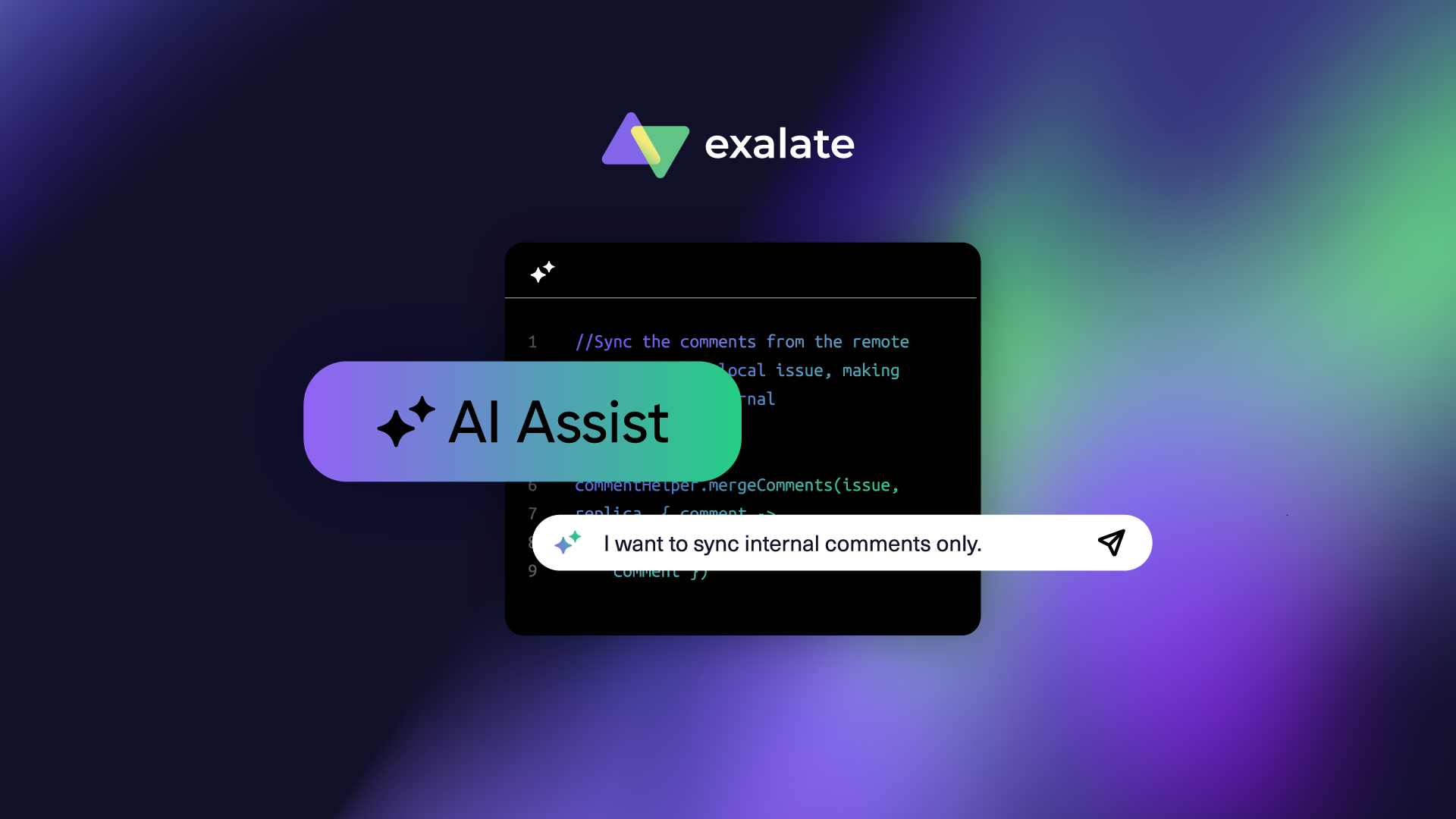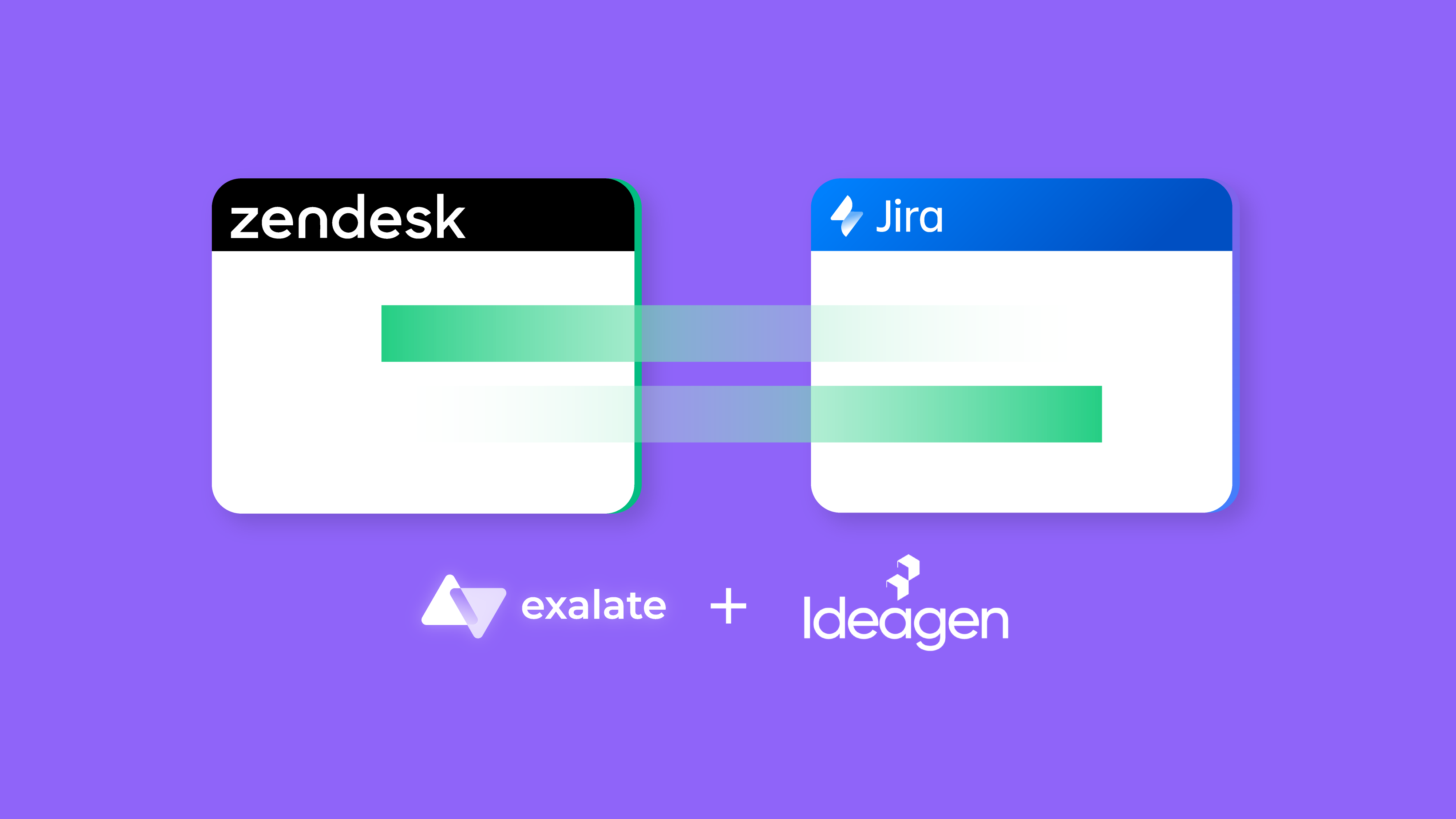ServiceNow has grown considerably from IT infrastructure services to supporting security, development, customer service, HR, and other teams. It has set a benchmark for its potential to detect anomalies and automate digital workflows and processes.
ServiceNow integrations extend the ability of ServiceNow by reducing siloed functional areas to increase productivity and efficiency.
So information can flow from other 3-rd party systems or applications into ServiceNow. At the same time, information from within ServiceNow can be displayed in other apps or systems.
This blog aims to explain why there is a need for ServiceNow integrations and the benefits it brings to teams. It also discusses the technologies ServiceNow natively offers for such integrations and explores other alternatives.
We then see a practical implementation of ServiceNow integrations using a 3-rd party app called Exalate. And finally, we end the blog by discussing a few best practices for ServiceNow integrations.
So let’s get started.
The Need for ServiceNow Integrations
ServiceNow’s bread and butter is incident management and resolution. However, it is not limited to only that. It also extends to other functional areas. So different teams like HR, software development, operations, etc. can use it just as easily.
These teams also need to interact with other teams using completely different applications like Jira, Salesforce, Azure DevOps, GitHub, etc. In fact, they might also want to interact with other ServiceNow instances their partners or suppliers use.

Maybe your service desk agents using ServiceNow need to escalate incidents to the dev team using Jira after they perform a root cause analysis. You want to resolve incidents faster to be more efficient.
But if you rely on transferring these incidents manually, then it’s easy to make errors and introduce delays for customers, further impacting your incident resolution times.
So there is a need for Jira and ServiceNow integrations to automate business functions between both platforms. All the information exchange is automatic, in real-time, and visible to the correct stakeholders within their own application. It will digitalize workflows and enrich the customer experience.
This is what ServiceNow essentially stands for and believes in the first place.
And who knows, this might just be the beginning! With the right technology and approach such ServiceNow certified integrations can enable a global network of B2B integrations blurring information boundaries.
ServiceNow Integrations: An Interconnected ServiceNow Ecosystem
Remember, the main aim of cloud integrations with ServiceNow is not to take the teams away from their original source of information but to streamline procedures and workflows to make their day-to-day operations easier.
Essentially, this means pulling data from external systems and displaying it within ServiceNow. It also includes displaying data from ServiceNow into these external systems.

ServiceNow integrations can take place in different ways:
- Data is moved across ServiceNow and different applications such that processes are automated end-to-end. For instance, sending ServiceNow incidents to Jira or Azure DevOps to facilitate the development workflows. ServiceNow coins this as Process integrations.
- Simple data exchange between different applications and ServiceNow. The transfer of such data can either be one-way or two-way, depending on the requirement. It can be pulling data from a data source (or database) and displaying it within ServiceNow. This is called Data integrations by ServiceNow.
- Display publicly available information within the ServiceNow platform. This is an example of UI Integration. In this case, a certain
<iframe>in ServiceNow is launched into another portal or vice versa. For instance, display a live report in another system.
ServiceNow integrations can either be batch-based or event-based.
Batch-based integrations allow you to exchange information in batches or in bulk. This can include information stored in CSV, Excel, or any other format.
Whereas, event-based integrations allow data to be exchanged whenever a certain event occurs. For instance, when an incident of urgency=1 and Priority=High, belonging to a specific Assignment group is encountered, a ServiceNow record needs to be passed over to the development team using Azure DevOps or Jira. Alongwith the required information, time-related information can also be synced for high-priority incidents.
Let’s look at the benefits of ServiceNow integrations.
Benefits of a ServiceNow Integration
If ServiceNow, as an ITSM solution, becomes the single source of truth for your organization connecting different teams and increasing collaborations, it can reap a lot of benefits:
- Easily route or reroute incidents within platforms you use and automate processes across different departments or even across different companies (cross-company integration).
Give away tedious, manual, repetitive tasks and let go of Excel sheets and to-do lists. - Better insights and reporting capabilities through data analytics tools that ServiceNow provides can help track customer requests, identify patterns, and deal with problems early on.
It can also measure key performance indicators like problem resolution times and agreed-on SLAs so as to develop an overall rich customer experience. Also, all the team members will have better visibility of every operation and process and can take advantage of this transparency to work efficiently. - The customization capabilities of ServiceNow are well-known and scalable. If these advantages are percolated to other platforms through integrations, it can increase productivity and enhance its performance further.
- Sometimes you need to connect multiple ServiceNow instances such that its pre-built applications like ITSM, HRSM, or CSM must integrate. This can bring diverse ServiceNow instances supporting diverse functions to be tied together within a single (or multiple) enterprise(s). This can help MSPs or MSSPs (using these instances) come together under a single workflow and increase productivity.
Further dwelling on the practical aspects of ServiceNow integrations, let’s see a few common use cases.
Common Use Cases for ServiceNow Integrations
Integration between ServiceNow and Other Applications
Let’s have a look at a few use cases when ServiceNow is connected to other commercially available work management systems like Jira, Azure, GitHub, Salesforce, Zendesk, etc.
Service Desk and Development Teams
Streamlined workflows and faster resolutions between the support and the development teams are the most important measures of delightful customers and increased business. This can happen when all the necessary – and only the required information – is passed between applications they use.

The time taken for an incident to flow across to the development team and be pushed back to the support team for resolution can open up insights. Insights where you can identify bottlenecks and patterns early on and take corrective actions.
Due to this increased transparency, efficiency increases by default. For instance, patch releases, if required, can be expedited, keeping the customer at the center of the business.
After all, this is what sound business judgments are all about.
IT and Business Teams
ServiceNow Integrations can provide end-to-end connectivity between IT and business teams. Business teams get valuable feedback (queries, problems, feature requests, etc) from customers, for instance, cases, in Salesforce.

If this feedback is handed over to the IT teams, they can help in making the product more valuable, incorporating proactive improvements. Information can then pass between these multiple applications such that all the teams work towards common business goals.
Integration between Different ServiceNow Instances
Sometimes, there is a need to connect multiple ServiceNow instances. Such integrations are often viewed as snaps (duplicate snapshots of 2 ServiceNow instances) of each other, but in reality, it is more than that.
Connecting MSPs to Multiple Clients
Managed service providers have to deal with multiple clients often not using the same application as the provider. Maybe they both use different ServiceNow instances. There is a need to pass some (not all) data between them.
Also, multiple clients can have different information requirements. Managing all this information through ServiceNow HR integrations can strengthen the relationship between the MSPs and their clients and make everyone’s life easier.

Having got an idea about the what and why of ServiceNow integrations, let’s get into the practical aspects of how such integrations can be achieved.
Native Ways to Implement ServiceNow Integrations
There are different technologies and methods it supports for integrating ServiceNow with external systems.
Exploring Various Integration Technologies Offered by ServiceNow
Depending on the most popular scenarios, like Incident Management, CMDB, Problem Management, etc., here is a comprehensive ServiceNow integrations list:
- Web Services
- ServiceNow allows all data objects to be used as web services for one or two-way data integration. Dynamic modifications to existing and new objects are directly published as Direct Web Service.
- Another way is through its Mapped Web Service, which allows mapping the incoming data into final target tables.
- There is a Scripted Web Service where data is sent and received between systems through triggers. So it’s more of an event-based service like we discussed above.
- External data can also be loaded via import sets in ServiceNow.
- Information can be pulled via a data source directly using a JDBC connection. Various data sources can be loaded, like Excel and CSV files, etc.
- ServiceNow can also pull user data from your instance’s existing LDAP server for integration.
- Other industry standard technologies like SOAP, REST, or WSDL are also supported.
- ServiceNow API integrations and command-line functions can also be done using a MID Server.
- A few single-sign-on technologies have been identified and provided integration for. This facilitates faster assimilation into the platform you use. This technique is also customizable through scripting, so you can incorporate it for your own SSO environment.
- ….
Obviously, the list is not exhaustive.
What Integrations Does ServiceNow Provide?
- ServiceNow provided Integrations that are accessible as a part of the platform. These do not come at an additional cost.
- ServiceNow Store Integrations that are built by ServiceNow or its partners. The support for the integration is usually provided by the vendor.
- IntegrationHub allows you to integrate ServiceNow with any API-enabled systems. By far, this is the most popular option for ServiceNow integrations.

It reflects the customization capability of ServiceNow for integrations by extending the functionality of its Flow Designer. IntegrationHub uses 3rd party APIs as a part of its flow and triggers information exchange.
An example of such a trigger can be an incident being created or updated. It achieves this in the form of different spokes. Each spoke is application-specific. There are spokes for Jira, GitHub, GitLab, Salesforce, etc., to connect ServiceNow with these platforms. There are around 175+ pre-built integration spokes.
ServiceNow also realizes the need to connect multiple ServiceNow instances with the help of an eBonding Spoke. This allows you to connect different ServiceNow instances with almost no code and is available OOB (no need for a subscription) with ServiceNow.
- Custom Integrations in ServiceNow allow you to use the platform’s own interfaces and build an integration from scratch. These are beneficial for very specific use cases but generally need to be maintained for the long term by the customers themselves. So they aren’t recommended.
As seen, there are a lot of ways to achieve integrations with ServiceNow natively, so it’s safe to say that you can choose to let your ServiceNow instance communicate with any other application of your choice.
But there are also a few caveats we must consider here.
Challenges of Implementing ServiceNow Native Integrations
Though at the onset, it may sound simple to implement the ServiceNow-provided integrations, often it is not.
When it comes to business decisions like these, it is important to have a look at what you expect from such an integration and whether it would be of any value, functionally and economically.
With ServiceNow-provided integrations, ServiceNow often sits at the orchestrating seat and drives them forward. Systems involved in such an integration are tightly coupled, creating dependencies and additional overheads for maintenance.

The main requirements of integrations in ServiceNow that can be fulfilled are limited at times in terms of capabilities since they are based on templates and patterns that are inherently provided. So they are perfect if you just want to automatically pull data from an external system and display it within ServiceNow or vice versa.
Nevertheless, for some advanced requirements, data mapping can be done using different technologies and methods we saw above. But then doing so requires additional coding efforts and additional resources. Not to mention the time taken to even get started is huge. It’s like building a bazooka to kill a mosquito!
For certain customizations in IntegrationHub, a request to the creator of the Spoke needs to be made. So it’s not always very simple.
Most of the ServiceNow-provided integrations are available for free, but some, like IntegrationHub, require a separate subscription. At times, the cost for this is too high, considering the efforts required to set up a simple integration.
Moreover, in IntegrationHub, since you aren’t able to pick a single integration, you can end up paying for the 175+ integration spokes that you might not even use.
And we still haven’t explored the role of 3-rd party vendors who also provide ServiceNow integrations. It’s time we do that.
Using 3rd-Party Apps for ServiceNow Integrations
There are various integrations in ServiceNow, which you can find in the store.
They are professionals and experts in ServiceNow integrations so it makes sense to discuss how we can use them to integrate ServiceNow with other applications.
But we must not be shooting in the dark.
To even reach a conclusion, there must be thorough research and an understanding of what the solution would bring to the table. Keep a few guidelines in your mind.
Checklist for Selecting the Right ServiceNow Integrations App
Security
The most important part of any integration, without any doubt, is security. This is because the entire essence of any integration lies in sharing data across different applications, and you don’t want unauthorized access to that data or accidental leaking of information.
So having an integration solution supporting encryption, secure file transfer protocols, role-based access control, etc., is a must. A common application can be found in ServiceNow security operations integrations.

A lot of companies are also concerned about where, what, and how data, would reside once it leaves their company or their ServiceNow instance.
Decentralized Integration
An important requirement for many scenarios is for the solution to support decentralized integration. All the solutions, including the ones provided by ServiceNow are centralized, meaning a single interface works as a controller for the integration.
And trust me, there is nothing wrong with this approach.
But now imagine a scenario where both the integrating platforms have equal and independent rights to choose how they want to send and receive information. This can happen without messing with each other’s integration setups or even informing the other side (unless required).

So you simply choose to send (or filter) information that is absolutely necessary to the other side and also decide what you want to receive from the other end independently.
Loosely- Coupled Systems
Continuing the point above, the systems in a decentralized integration setup are intrinsically loosely coupled. When systems don’t depend on each other (avoiding a single point of failure) it increases the overall scalability.
So it’s very easy to add just another point of integration and connect with a new partner.
Flexibility
With integrations, you always have a lot of options. Because there is no “one-size-fits-all” kind of scenario. Requirements change and so does the way in which data exchange is handled. Sometimes, you might have extremely complex needs that have to be implemented by integrating at a deeper level with the platforms.
Now, all of this, as I mentioned before, can also be achieved with ServiceNow-provided integrations or with other solutions in the market.
But the point here is the ease with which this can be achieved.

How much time and effort would the task require? Is it something that the solution can achieve in less time with minimal tweaking and native support for deep integrations? Is there an option to use AI? And in the end, is it all even worth it? Would it help in reducing your organization’s technical debt?
Having a solution flexible enough to implement any and every integration requirement should be your best shot.
Price
Last but not least, perhaps the most important point businesses want to consider is the price of the integration solution. Please be mindful: this is not the same as the cost of an integration, which is a completely different ball game.
Are you paying too much for a simple integration, or are you paying a reasonable price for an advanced integration? These are just some of the few questions you must ask yourself.

Well, are we getting somewhere with all of this?
Yes, I have an integration solution that can be a fit here.
Exalate: a 3-rd Party Integration Solution for ServiceNow Integrations
Exalate is a one or two-way integration solution with the capability to provide bespoke integrations for different ITSM, ITOM, CRM, or other work management systems.
It supports integrations for ServiceNow, Jira, GitHub, Azure DevOps, Salesforce, Zendesk, etc, and you can use its Integration as a Service to set up an integration between any two platforms, including legacy systems.
You can set up a ServiceNow to Azure DevOps integration, a ServiceNow to ServiceNow integration, or even a Jira to Azure DevOps integration for that matter.
It supports a smaller range of platforms as compared to IntegrationHub but the integration that can be delivered is way deeper. Because it comes with a built-in intuitive scripting engine that allows you to customize mappings and the overall logic to an advanced level.

It is also the only solution that supports decentralized integration, and as we discussed, gives equal and independent rights to either side of the integration.
Plus, it keeps the integrating systems loosely coupled and increases security since both sides decide what information they want to expose.
Let’s see a step-by-step walkthrough on how to use Exalate to set up ServiceNow integrations.
How to Set up ServiceNow Integrations with Other Apps or Systems
Note: You can watch the Exalate Academy tutorials if you are a visual learner.
Step 1: Install Exalate on ServiceNow and the Other Application
The first step is to install Exalate on ServiceNow and then on the other platforms (Jira, Azure DevOps, ServiceNow, GitHub, Zendesk, Salesforce, etc).

You can request your Exalate for ServiceNow and other instances via the integrations page. Fill in the required information and our team will reach out to you with the Exalate node.
Alternatively, you can install Exalate from the Atlassian marketplace.
Note: Exalate for ServiceNow can also be installed on docker.
Step 2: Connect ServiceNow and the Other Application
To start syncing information, you first need to set up a connection between ServiceNow and the other application.
One side initiates the connection and generates an invitation code. The other side accepts the connection invitation using this invitation code. A connection generates a link between the 2 platforms so you can synchronize information.
It doesn’t matter which side starts initiating the connection, the Exalate UI remains the same.
Assume we start initiating the connection from ServiceNow.
Navigate to the “Connections” screen in the Exalate console on the left-hand side menu bar.
Click on the “Initiate Connection” button.

Enter the “Destination Instance URL”. The destination instance URL is the URL of the application you need to sync with. I have considered Jira in this example. But it can be any other application Exalate supports.

You will need to choose between the Basic and the Script mode.
The Basic mode supports pre-defined field mappings between the different systems that cannot be configured. You can sync only incidents in ServiceNow using the Basic mode. It comes with a Free Plan that allows you 1000 free syncs per month. It lets you test out your sync easily.
The Script mode is where the real power of Exalate lies.
It works on a Groovy-based scripting engine and you can specify and manipulate the fields you want to share. You can also define how to map them and automatically control the sync the way you want. This mode also comes equipped with AI. We will see how that works in the Script mode section.
Let’s have a look at the Basic mode first before we go to the Script mode.
The Basic Mode
Select “Basic” in the option above and click “Next”.
You will need to verify if you have admin access to the destination instance or not.

Once that is done, depending on the destination instance you would either need to select a project in Jira and Azure DevOps or a repository in GitHub, or if no such concept exists then the connection is successfully established.
You can enter the incident number.

And see the result of your synchronization immediately.

You can also choose to filter incidents that can be synced using the basic mode automatically with the help of triggers or you can even sync entities in bulk.
The Script Mode
Choose “Script” and click “Next”.
Enter the connection details. Give a short name to the local instance and a short name to the remote instance. A connection name is automatically generated. You can change it if you want to.

Click “Next”.
An invitation code is generated. This needs to be copied and pasted into the destination instance.
So click on “Copy invitation code” and save it somewhere safe. Then click “Done”.

On the destination instance, go to the Exalate console and select the “Connections” tab.
This time around, click the “Accept invitation” button.
Paste the code you have just copied. Again, depending on the destination instance, you will either be required to choose a project or a repository, or the connection will be successfully established.

Step 3: Configure the Connection to Decide What to Share
On the previous screen, if you click “Configure Sync” you will be shown a panel that looks like this:

“Rules” and the “Triggers” tabs are the ones we need here.
Rules are Groovy scripts that let you control the information flow.
There are Incoming and Outgoing sync scripts present on both integrating sides. They control the information flowing out and coming into the platforms. Each line corresponds to a particular field that needs to be synced.
In the “Outgoing sync” on the ServiceNow side, the line replica.description=entity.description, means that the description of the ServiceNow entity is copied into something called a replica.
Replica acts like an empty envelope in which you fill in the contents you need to transfer to the other side. This content is unraveled at the destination instance and applied according to the rules defined in its “Incoming sync”.
If you don’t want to send a particular field, simply delete the line.
You can also choose to add new lines of code to send or receive new information.
Check out the Getting started guide on the Exalate documentation to see how these initial steps work out with Exalate or refer to the Script Helpers for advanced scripting logic.
Use AI Assist for Configuring Your ServiceNow Integrations
Exalate’s Script mode now features AI Assist, accessible via a chat window in both the incoming and outgoing sync rules tabs. Simply type in your sync requirements, and AI Assist will generate the necessary scripts for you.
The scripts are created based on your input, current configurations, and Exalate’s scripting API, and should appear shortly.
In the generated script, red lines show what will be removed, while green lines indicate new additions. You have the option to accept, reject, or refine these changes, adjusting your prompt as needed. Once you’re satisfied, remember to publish your changes.
Like any AI tool, AI Assist isn’t perfect and can sometimes miss the mark. To achieve the best results, ensure your prompts are as clear and specific as possible.
For instance, if you need to map statuses between Jira and ServiceNow, you could enter something like this into the AI chat:

Step 4: Start Automatic Synchronization Using Triggers
Once you have decided what information must be sent and received, you might want to start the synchronization process automatically based on certain events.
This is done via Triggers in Exalate. Based on the conditions (filters) you set, sync will happen in accordance with the Sync Rules.
Triggers are platform-specific and need to be set on both sides of the integration if you want a two-way sync.
To create one, click the “Create Trigger” button.

Choose the entity you want to set the trigger for.
On the ServiceNow side, you can choose between incidents, RITMs, problems, change requests, etc. In the “If” section, use the ServiceNow search syntax. Entities that meet the conditions are automatically synced.
You can write advanced triggers like syncing incidents assigned to a particular person or syncing incidents that have a particular text in a comment or description.

Once done, leave some notes and activate the trigger.
You can see the trigger you just created in the list.
You can choose to sync all the existing entities that satisfy the trigger conditions using the “Bulk Exalate” option.
After you have made changes to the Connection in Steps 3 and 4, hit the “Publish” button to apply them.
Step 5: Start the Synchronization
Honestly, there is nothing you need to do in terms of starting the sync.
It will start automatically based on the triggers you have set up. If for some reason it doesn’t, grab some coffee and by the time you are back, it will be working just fine.
If there are some issues with the triggers or rules, you can also troubleshoot and find out what’s going wrong.
Best Practices for ServiceNow Integrations
The possibilities with integrations are huge and you can go downhill in a short amount of time without realizing what went wrong.
So let’s look at a few best practices and see how you can make the most out of your ServiceNow Integration.
To be honest, these are not specific to only ServiceNow, they stand true for all kinds of integrations.
- Set a goal for your integration and define the requirements early on.
Ask questions like:- Do I really need integration in the first place?
- What other ways are there to connect the platforms I use every day?
- What business value will the integration bring?
- Which processes will the integration have an impact on?
If all the answers point towards integration, you know you have headed the correct way.
- Stressing on the above point a little, make sure you chalk down to the finest details what data needs to be exchanged, at what time, what workflow is expected to be automated, how it is mapped to the destination instance, and so on.
- Involve the right stakeholders in the process from the beginning. Right from the inception, design, and implementation to the maintenance of the integration. They can be the platform admins, the implementation team, data architects, solution architects, information security consultants, or absolutely anyone you think can add value to the project.
- Explore the technologies and options available for integrating your systems. We have discussed ServiceNow integrations here (and I hope it brought some clarity) but they might as well be Jira integrations or Salesforce integrations. This is an important step to put your integration in full throttle.
Also, check how the integration handles your data and GDPR requirements since it is an important part of an integration. - Make sure to not rush through the integration. It is a time-consuming process, accept it, especially the trial and error or the POC part. So give it that kind of time. Your integration can be complex and can take time to set up. Acknowledge that instead of rushing through and being left with a clumsily-working high-maintenance result.
- Sometimes, you can have obvious solutions to your problems. For instance, JDBC works really well if you want a one-way integration between a data source and ServiceNow, i.e., just pulling the data from the source and displaying it in ServiceNow. For two-way integrations between different platforms, you can use a web service or a MID server, or a third-party app like Exalate.
- Determine how and where the system you want to connect with is located. Is it inside the customer’s network and needs update via a MID server or is it across company borders? You can involve a subject matter expert and get the right direction in this case.
- With ServiceNow, you already have basic system integrations like eBonding, Google Maps, etc. Understand and use these technologies. For advanced integrations, go to the experts.
- Some tools like IntegrationHub support workflow automation and focus on that alone, whereas some others like Exalate focus on deeper integrations that involve a lot of advanced integration requirements.
Be sure to have this understanding from the beginning. If in doubt, check how you can make the right decision between IntegrationHub and Exalate.
There is a lot that can happen with integrations and the sky’s the limit. And with the right approach, it becomes unstoppable. So choose wisely and decide what works best for you.
Conclusion
We have come a long way. Having started with understanding the needs and benefits of ServiceNow Integration, we also saw a few use cases to get a practical view of how such integrations can be envisioned.
You also learned all about the native ServiceNow-provided integration technologies and methods. As opposed to these, we had a look at why 3-rd party applications can also be a good choice.
We then briefly touched on an integration solution called Exalate, which has a distributed architecture and supports decentralized integration, an intuitive scripting engine, and so on.
Finally, we saw how ServiceNow integrations can be implemented using Exalate before closing the journey with a few best practices.
There is always more to learn, so feel free to book a demo with Exalate if you think it can be the right solution for you and see where that leads you.
Frequently Asked Questions
What are ServiceNow Integrations?
ServiceNow integrations help establish connections between ServiceNow, a popular ITSM platform, and other applications, databases, or services. These integrations help automate workflows and tasks, centralize information, and improve overall organizational efficiency by connecting ServiceNow with other critical business systems.
What is REST API integration in ServiceNow?
REST API integration in ServiceNow refers to the capability of ServiceNow to interact with other systems using the Representational State Transfer (REST) architectural style. ServiceNow provides a RESTful API that allows developers to make HTTP requests to perform operations on ServiceNow data and functionalities.
However, this method of integration requires a lot of development effort and technical resources. It’s also difficult to scale the integration. Hence, external integration software vendors like Exalate can help achieve the same results with minimal effort.
How to integrate ServiceNow with ServiceNow?
You can integrate multiple ServiceNow instances using ServiceNow eBonding spoke. It works well for simple integration requirements. Use third-party integration apps to implement advanced ServiceNow integrations.
What applications integrate with ServiceNow?
ServiceNow integrates with various applications, including CRM systems (Salesforce, Microsoft Dynamics), collaboration platforms (Microsoft Teams, Slack), project management platforms like Jira, development platforms like GitHub and Azure DevOps, other ServiceNow instances, and many more.
Which tool is used to integrate ServiceNow?
You can use third-party integration tools such as Exalate to integrate ServiceNow with other applications uni or bi-directionally. This tool allows you to create custom Groovy scripts to sync any kind of ServiceNow entities like Incidents, Problems, Change Requests, RITM, etc.
Recommended Reads:
- ServiceNow to ServiceNow Integration: The Step-by-Step Guide to Setting up a Two-Way Sync
- Jira ServiceNow Integration: How to Set up an Integration in 6 Steps
- Salesforce Integrations: Integrate Salesforce and other Tools
- Jira Integrations: Integrate Jira and Other Systems Bidirectionally
- How to Set up a Salesforce ServiceNow Integration (Step-by-Step Guide)









